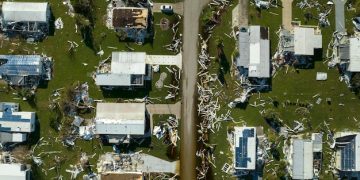Understanding FEMA Assistance: Maximize Benefits After US Disasters

Understanding FEMA Assistance is crucial for US residents affected by disasters, offering various programs and resources to help with recovery and rebuilding efforts; it’s essential to know how to navigate the application process and maximize the available benefits.
Understanding FEMA Assistance: Maximizing Your Benefits After a Disaster in the US is essential for anyone affected by natural catastrophes. The Federal Emergency Management Agency (FEMA) offers a range of programs and resources to help individuals, families, and communities recover and rebuild. Navigating the application process and understanding the available benefits can significantly ease the burden of recovery.
Understanding FEMA: A Lifeline After Disaster Strikes
FEMA, the Federal Emergency Management Agency, plays a pivotal role in disaster relief across the United States. But what exactly does FEMA do, and how can it help you when disaster strikes? Understanding its function is the first step in accessing the assistance you need.
FEMA’s core mission is to support citizens and first responders to ensure that as a nation we work together to build, sustain, and improve our capability to prepare for, protect against, respond to, recover from, and mitigate all hazards.
What Does FEMA Do?
FEMA provides a wide range of assistance programs, including grants for temporary housing, home repairs, and other essential needs. They also offer resources for disaster preparedness and mitigation to help communities become more resilient.
Who is Eligible for FEMA Assistance?
Eligibility for FEMA assistance generally depends on several factors, including:
- The type and severity of the disaster
- Your residency status
- Your insurance coverage
- Your income and resources
Typically, FEMA assists individuals and households that have uninsured or underinsured losses resulting from a declared disaster.
In summary, FEMA stands as a crucial resource for individuals and communities grappling with the aftermath of disasters, offering support that extends from immediate relief to long-term recovery strategies.

Applying for FEMA Assistance: A Step-by-Step Guide
The application process for FEMA assistance can seem daunting, but breaking it down into manageable steps can make it more approachable and less stressful. Knowing what to expect and having the necessary documentation ready can expedite the process.
Here’s a step-by-step guide to help you navigate the FEMA application process effectively.
Gather Necessary Documentation
Before you begin your application, gather all the necessary documents. This typically includes:
- Proof of identity (e.g., driver’s license, passport)
- Proof of address (e.g., utility bill, lease agreement)
- Insurance documentation
- Documentation of damage and losses
Register Online or by Phone
You can register for FEMA assistance online through the FEMA website or by calling the FEMA helpline. Be prepared to provide detailed information about the damage to your property and your insurance coverage.
After registering, you will receive a FEMA registration number. Keep this number handy, as you will need it for all future communications with FEMA.
Schedule an Inspection
In many cases, FEMA will schedule an inspection of your damaged property to assess the extent of the damage. It’s important to be present during the inspection and to provide any additional information or documentation that the inspector may request.
In conclusion, by gathering necessary documents, registering properly, and understanding the inspection process, you can effectively navigate the initial stages of applying for FEMA assistance.
Understanding FEMA Assistance Programs
FEMA offers a variety of assistance programs to help individuals and communities recover from disasters. These programs are designed to address different needs, from temporary housing to home repairs and medical expenses. Understanding the types of assistance available can help you maximize the benefits you receive.
Let’s explore some of the key FEMA assistance programs.
Individuals and Households Program (IHP)
The Individuals and Households Program (IHP) provides financial assistance and direct services to eligible individuals and households who have sustained losses as a result of a disaster. This program can help with:
- Temporary housing
- Home repairs
- Replacement of essential household items
- Medical and dental expenses
Public Assistance Program
The Public Assistance Program provides grants to state, local, and tribal governments, as well as certain private nonprofit organizations, for disaster-related expenses. This program helps communities rebuild infrastructure, such as roads, bridges, and utilities.
Hazard Mitigation Grant Program (HMGP)
The Hazard Mitigation Grant Program (HMGP) provides funding to state and local governments to implement long-term hazard mitigation measures after a disaster. This program helps communities reduce the risk of future damage from similar events.
In summary, FEMA’s diverse assistance programs address a wide range of needs, ensuring that individuals, families, and communities can recover and rebuild after a disaster.
Maximizing Your FEMA Benefits: Tips and Strategies
Getting approved for FEMA assistance is just the first step. To truly maximize your benefits, it’s essential to understand the rules and regulations, stay informed about deadlines, and advocate for your needs throughout the recovery process. Here are some tips and strategies to help you make the most of FEMA assistance.
Follow these tips to ensure you are getting the most out of the benefits available.
Keep Detailed Records
Keep detailed records of all disaster-related expenses, including receipts, invoices, and estimates. This documentation can be crucial in supporting your application and appealing any decisions you disagree with.
Stay Informed About Deadlines
Be aware of all deadlines for applying for assistance, submitting documentation, and appealing decisions. Missing a deadline can jeopardize your eligibility for benefits.
Appeal Decisions if Necessary
If you disagree with a FEMA decision, you have the right to appeal. Be sure to submit your appeal in writing within the specified timeframe, and provide any additional documentation or information that supports your case.
By keeping detailed records, staying informed about deadlines, and being prepared to appeal decisions, you can increase your chances of maximizing your FEMA benefits and achieving a successful recovery.

Avoiding Common Pitfalls in Your FEMA Application
Navigating the FEMA application process can be challenging, and it’s easy to make mistakes that can delay or even disqualify your application. Being aware of common pitfalls and taking steps to avoid them can save you time and frustration.
Here are some common mistakes to avoid when applying for FEMA assistance.
Incomplete Applications
One of the most common mistakes is submitting an incomplete application. Make sure you fill out all required fields and provide all necessary documentation. Double-check your application before submitting it to ensure that nothing is missing.
Lack of Documentation
Failing to provide adequate documentation can also delay or disqualify your application. Be sure to include all required documents, such as proof of identity, proof of address, and insurance documentation. If you don’t have certain documents, explain why and provide alternative evidence if possible.
Misrepresenting Information
Providing false or misleading information on your application can have serious consequences. Be honest and accurate in your responses, and don’t exaggerate the extent of your damage or losses.
Duplication of Benefits
Receiving duplicate benefits from multiple sources can result in having to repay FEMA for assistance you received. It is critical to provide all documentation about assistance you may have received from other sources for the same loss.
By avoiding these common pitfalls, you can increase your chances of a smooth and successful FEMA application process.
Additional Disaster Assistance Resources: Beyond FEMA
While FEMA is a primary source of disaster assistance, it’s important to remember that there are many other organizations and resources available to help you recover. Exploring these additional resources can provide you with a more comprehensive support network.
Here are a few additional disaster assistance resources to consider.
The American Red Cross
The American Red Cross provides immediate assistance to disaster victims, including shelter, food, and basic medical care. They also offer long-term recovery support, such as counseling, case management, and financial assistance.
Local Community Organizations
Many local community organizations offer disaster assistance, such as food banks, clothing closets, and housing assistance programs. These organizations can provide essential support to help you get back on your feet.
Religious Organizations
Religious organizations often play a significant role in disaster relief, providing volunteer labor, donations, and spiritual support. Many churches and other religious groups offer assistance to people of all faiths.
Exploring assistance beyond FEMA can significantly enhance your recovery efforts. From the immediate support offered by the American Red Cross to the community-based assistance provided by local and religious organizations, diversifying your resources can make a substantial difference.
| Key Point | Brief Description |
|---|---|
| 🏠 FEMA’s Role | Provides support to citizens and first responders for disaster preparedness and recovery. |
| 📝 Application Steps | Involves gathering documents, registering online or by phone, and scheduling an inspection. |
| 💰 Assistance Programs | Includes IHP, Public Assistance, and HMGP for various needs. |
| ❤️ Other Resources | Organizations like the Red Cross, local groups, and religious organizations offer additional support. |
Frequently Asked Questions (FAQ)
FEMA, the Federal Emergency Management Agency, supports citizens and first responders to build, sustain, and improve the nation’s capability to prepare for, protect against, respond to, recover from, and mitigate all hazards.
Eligibility typically depends on the disaster’s severity, residency status, insurance coverage, and income. FEMA primarily aids those with uninsured or underinsured losses from a declared disaster.
You can apply online through the FEMA website or by calling the FEMA helpline. Gather necessary documents such as proof of identity, proof of address, and insurance documentation before applying.
FEMA offers various assistance programs, including the Individuals and Households Program (IHP) for temporary housing, home repairs, replacement of essential items, and the Public Assistance Program for community infrastructure.
If your application is denied, you have the right to appeal. Submit your appeal in writing within the specified timeframe, including any additional documentation or information to support your case.
Conclusion
Understanding FEMA Assistance: Maximizing Your Benefits After a Disaster in the US is crucial for those affected by disasters. By understanding FEMA’s role, navigating the application process, and exploring additional resources, you can maximize your recovery efforts and rebuild your life after a devastating event.





